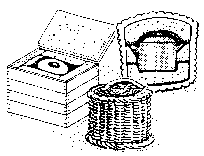http://solarcooking.org/ret-heat.htm
A very practical way to reduce fuel consumption when cooking grains and other long cooked foods.
Retained Heat Cooking
Once food is heated to boiling, cooking can continue in an insulated box
 Daily cooking [on a stove or over a fire] frequently includes a long simmering period which is required for many beans, grains, stews, and soups. The amount of fuel needed to complete these cooking processes can be greatly reduced by cooking with retained heat.
Daily cooking [on a stove or over a fire] frequently includes a long simmering period which is required for many beans, grains, stews, and soups. The amount of fuel needed to complete these cooking processes can be greatly reduced by cooking with retained heat.
Even today, in some parts of the world, a pit is dug and lined with rocks previously heated in a fire. The food to be cooked is placed in the lined pit, often covered with leaves. Then the whole thing is covered with a mound of earth. The heat from the rocks cannot [easily] escape and the food is cooked very slowly.
Another version of this method consists of digging a pit and lining it with hay or another good insulating material. A pot of food which has previously been heated up to a boil is placed in the pit, covered with more hay and earth, and allowed to cook slowly with the retained heat.
This latter method is the direct ancestor of the "Haybox Cooker," which is simply a well-insulated box or basket lined with a reflective material into which a pot of food previously brought to a boil is placed. The insulation greatly slows the loss of conductive heat, and the shiny lining reflects the radiant heat back into the pot. This works best when the pot fits snugly into the insulation with no air in between.
Such a box or basket can easily be made of inexpensive, locally available materials. It can be wooden, or cardboard, or any combination. Hay, straw, rushes, feathers, sawdust, rags, wool, shredded paper, etc. are all good insulating materials.
 Principles to be kept in mind are these:
Principles to be kept in mind are these:
(This above portion of this article was excerpted from Cooking with the Sun, State Technical College, Altötting, Neuötting Str. 64 c, 84503, Altötting, Germany) Using an SBC as a "Haybox"
When combining retained heat and solar cooking, if food has gotten thoroughly hot in an SBC, but clouds arrive before the food is finished cooking, a switch from solar to retained heat cooking should be made before the oven temperature drops below the boiling point. For large recipes this may be accomplished by simply closing the reflective lid on the pots of cooking foods. For smaller recipes, the solar oven is opened, taking care not to allow steam to escape from under the lids, pots are pushed close together along with any heated additional mass. Insulating pads or soft cushions are tucked closely around the pots and well heated mass. The SBC lid is then closed. This effectively makes the transition from solar to retained heat cooking. The cooker lid remains closed until shortly before serving time, when the food is tested. If not completely done, a very little conventional fuel will usually finish the job. Usually solar/retained heat cooking is done right where the SBC is located. However, a lightweight portable SBC can be moved temporarily indoors for its retained heat cooking time if the sun clouds over or if it rains. It may also be brought inside more or less permanently during the off season or at night and function as an insulated box for retained heat cooking. Used in this way the SBC continues to save fuel rather than simply being stored until conditions are right for solar cooking.
This document is published on The Solar Cooking Archive at http://solarcooking.org/ret-heat.htm. For questions or comments, contact webmaster@solarcooking.org
A very practical way to reduce fuel consumption when cooking grains and other long cooked foods.
Retained Heat Cooking
Once food is heated to boiling, cooking can continue in an insulated box
 Daily cooking [on a stove or over a fire] frequently includes a long simmering period which is required for many beans, grains, stews, and soups. The amount of fuel needed to complete these cooking processes can be greatly reduced by cooking with retained heat.
Daily cooking [on a stove or over a fire] frequently includes a long simmering period which is required for many beans, grains, stews, and soups. The amount of fuel needed to complete these cooking processes can be greatly reduced by cooking with retained heat. Even today, in some parts of the world, a pit is dug and lined with rocks previously heated in a fire. The food to be cooked is placed in the lined pit, often covered with leaves. Then the whole thing is covered with a mound of earth. The heat from the rocks cannot [easily] escape and the food is cooked very slowly.
Another version of this method consists of digging a pit and lining it with hay or another good insulating material. A pot of food which has previously been heated up to a boil is placed in the pit, covered with more hay and earth, and allowed to cook slowly with the retained heat.
This latter method is the direct ancestor of the "Haybox Cooker," which is simply a well-insulated box or basket lined with a reflective material into which a pot of food previously brought to a boil is placed. The insulation greatly slows the loss of conductive heat, and the shiny lining reflects the radiant heat back into the pot. This works best when the pot fits snugly into the insulation with no air in between.
Such a box or basket can easily be made of inexpensive, locally available materials. It can be wooden, or cardboard, or any combination. Hay, straw, rushes, feathers, sawdust, rags, wool, shredded paper, etc. are all good insulating materials.
 Principles to be kept in mind are these:
Principles to be kept in mind are these:- Insulation should cover all six sides of the box.
- The box should be airtight.
- The inner surfaces of the box should be of a heat-reflective material.
- Less water should be used since it is not boiled away.
- Less spice in needed since the aroma is not boiled away.
- Cooking must be started earlier to give the food enough time to cook at a lower temperature than on the solar cooker or over a fire.
- The food should boil for several minutes before being placed in the box. This ensures that all the food is at boiling temperature, not just the water.
- Haybox cookers work best for large quantities, as small amounts of food have less thermal mass and cool Preheated stones could always be put in together with the pot to prove the additional thermal mass needed to keep the temperature up over a long period of time.
(This above portion of this article was excerpted from Cooking with the Sun, State Technical College, Altötting, Neuötting Str. 64 c, 84503, Altötting, Germany) Using an SBC as a "Haybox"
When combining retained heat and solar cooking, if food has gotten thoroughly hot in an SBC, but clouds arrive before the food is finished cooking, a switch from solar to retained heat cooking should be made before the oven temperature drops below the boiling point. For large recipes this may be accomplished by simply closing the reflective lid on the pots of cooking foods. For smaller recipes, the solar oven is opened, taking care not to allow steam to escape from under the lids, pots are pushed close together along with any heated additional mass. Insulating pads or soft cushions are tucked closely around the pots and well heated mass. The SBC lid is then closed. This effectively makes the transition from solar to retained heat cooking. The cooker lid remains closed until shortly before serving time, when the food is tested. If not completely done, a very little conventional fuel will usually finish the job. Usually solar/retained heat cooking is done right where the SBC is located. However, a lightweight portable SBC can be moved temporarily indoors for its retained heat cooking time if the sun clouds over or if it rains. It may also be brought inside more or less permanently during the off season or at night and function as an insulated box for retained heat cooking. Used in this way the SBC continues to save fuel rather than simply being stored until conditions are right for solar cooking.
This document is published on The Solar Cooking Archive at http://solarcooking.org/ret-heat.htm. For questions or comments, contact webmaster@solarcooking.org
 The Japanese was the first to invent the thermal cooking pot which uses trapped heat to cook food.
The Japanese was the first to invent the thermal cooking pot which uses trapped heat to cook food. <!-- END: Shopzilla Publisher Asset HTML --> and <!-- BEGIN: Shopzilla Publisher Asset HTML -->
<!-- END: Shopzilla Publisher Asset HTML --> and <!-- BEGIN: Shopzilla Publisher Asset HTML -->  <!-- END: Shopzilla Publisher Asset HTML -->. Both are Japanese brands.
<!-- END: Shopzilla Publisher Asset HTML -->. Both are Japanese brands.
Comment